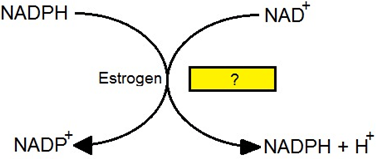This set of Molecular Endocrinology Multiple Choice Questions & Answers (MCQs) focuses on “Estrogens-Metabolic Role”.
1. After Administration of Estrogens what biochemical changes are observed in vaginal epithelial cells and endometrium?
a) Proliferation
b) Disruption
c) Regeneration
d) Transformation
View Answer
Explanation: There is a proliferation of vaginal epithelium and endometrium following estrogen administration. Also, there is an increase of glycogen in the cells and an increase in alkaline phosphatase production in the endometrium.
2. What is the role of estrogen in the glucose metabolism of the vagina?
a) Decreases glycolysis
b) Increases glycolysis
c) Glycogenolysis is promoted
d) Gluconeogenesis is promoted
View Answer
Explanation: Through lactic acid deposition, there is an elevated rate of glycolysis. Vaginal glycogen is the source of LA, which favors a homogeneous flora of acidic bacteria by increasing vaginal acidity (pH 4.0 to 5.0).
3. What is the role of estrogen in protein synthesis?
a) Decreases
b) Inhibits
c) Increases
d) Causes breakdown
View Answer
Explanation: Acceleration of the absorption of amino acids into uterine proteins by estrogen enhances the synthesis of proteins. This is followed by an increase in activity of the RNA polymerase and synthesis of RNA.
4. β-Estradiol prevents osteoporosis.
a) True
b) False
View Answer
Explanation: β-Estradiol reduces osteoporosis, which is often found as estrogen falls in menopausal women. Due to bone weakening from osteoporosis, menopausal women are likely to get fractures. Osteoporosis is a bone disease that occurs when too much bone is removed from the body, too little bone is formed, or both.
5. Estrogen is in favor of Ca and P retention and elevation.
a) True
b) False
View Answer
Explanation: Estrogen favors Ca and P retention and elevation, and Ca skeletal deposition. This contributes to bone calcification and ossification, and hypercalcemia and hyperphosphatasemia. Lower serum calcium and phosphorus levels are correlated with hormone therapy (ET) and are believed to increase bone mineral density (BMD).
6. What is the role of estrogen in mineral metabolism?
a) Sodium reabsorption
b) Sodium retention
c) Calcium retention
d) Calcium reabsorption
View Answer
Explanation: An effect on mineral metabolism is also caused by estrogens. A minor retention of Na, Cl and water is caused by β-Estradiol in particular. There is evidence that estrogen-related sodium retention is mediated by aldosterone and that improvements in electrolyte handling associated with oestrogen are a result of changes in the binding sites of the aldosterone distal tubule or a direct effect of oestrogen on the proximal tubule.
7. What is the role of estrogen in lipid metabolism?
a) Lipotropic effect
b) Lipolysis
c) Lipid anabolism
d) Lipid catabolism
View Answer
Explanation: Estrogens can exert a ‘lipotropic effect’ in certain mammalian species. This is the tendency to avoid fat in the liver from accumulating. Estrogens control mRNA production at the cellular level for various proteins, including proteins involved in lipid metabolism.
8. How is estrogen activity in pre-menopause stage is related to cholesterol levels?
a) Decreased LDL levels
b) Increased LDL levels
c) Decreased HDL levels
d) Increased HDL levels
View Answer
Explanation: Young women are protected from myocardial infarction, while menopausal women are more vulnerable to myocardial infarction, with a reduction in estrogenic activity. During pre-menopause, estrogenic activity is associated with elevated HDL levels.
9. Which is the enzyme that carry out the reaction given below?

a) Transhydrogenase
b) Dehydrogenase
c) Aromatase
d) Isomerase
View Answer
Explanation: Estrogens can also serve as a transhydrogenation reaction cofactor in which H+ ions and electrons are moved to NAD+ from reduced NADP+. The transition of H+ from NADPH to NAD+ is catalyzed by estrogen dependent transhydrogenase.
10. What is the role of estrogens in the maintenance of cholesterol levels?
a) Cholesterol elevating effect
b) Cholesterol lowering effect
c) Cholesterol breakdown
d) Cholesterol synthesis
View Answer
Explanation: Estrogens have a lowering effect on cholesterol. This lowers the amount of plasma cholesterol which allows the β-lipoprotein level to decline. Estrogen works by lowering the overall amount of cholesterol in the body, rising the amount of good cholesterol (HDL) and decreasing the amount of bad cholesterol in the liver (LDL).
Sanfoundry Global Education & Learning Series – Molecular Endocrinology.
To practice all areas of Molecular Endocrinology, here is complete set of 1000+ Multiple Choice Questions and Answers.
If you find a mistake in question / option / answer, kindly take a screenshot and email to [email protected]
